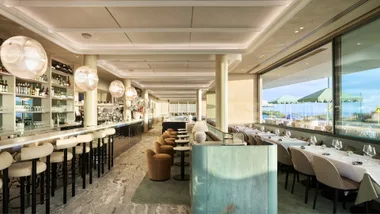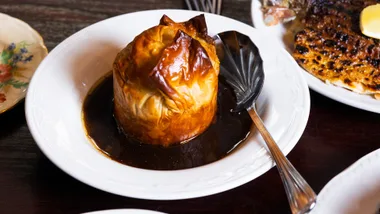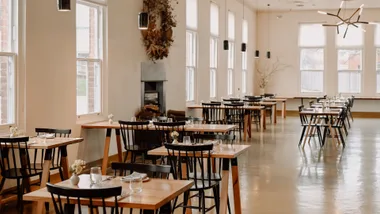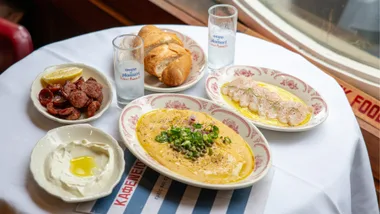Sepia
Ground floor, Darling Park, 201 Sussex St, Sydney, NSW, (02) 9283 1990, sepiarestaurant.com.au.
Cards AE DC M V.
Open Lunch Mon-Fri noon-3pm; dinner Mon-Fri 6pm-10pm.
Prices Entrées $22-$26; mains $34-$45; desserts $17-$20; dégustation $130.
Noise Terrible music.
Vegetarian One entrée, one main, dégustation on request.
Wheelchair access Yes.
Plus One of the city’s brightest chefs strikes out on his own.
Minus Some dishes can seem more thought than felt.
If you’re after a blueprint of tomorrow’s Sydney restaurant today, start looking at Sepia. Ingredients here are poached, creamed, powdered and jellied rather than char-grilled, wood-roasted or deep-fried. In this kitchen, there’s no deep-fryer; immersion circulators and Thermomix machines rule this roost. The word confit appears on the menu seven times, possibly an Australian record.
In the face of this futurism, the dining room is more about chasing an idea of yesteryear, a corporate-luxe vision of the big-city Madison Avenue restaurant that may or may not have actually existed. Carpeted rooms sit to the left and right of a mirrored and marble-floored bar in the moneyed Manhattan steakhouse style, rendered in polite and plush echoes of Deco and Memphis. The palette is brown, black, olive and navy, marble and timber, yet on the palate Sepia is as much daikon and nori as it is celery leaf and radishes.
This world of quiet confidence and creative order is the brainchild of Martin Benn and Vicki Wild. The pair both worked at Tetsuya’s for some time. British-born Benn was head chef for many years and Wild was Tetsuya Wakuda’s assistant. This is the first time Benn has run a kitchen of his own devising. His stint at The Boathouse on Blackwattle Bay was undoubtedly one of the more shining moments in that restaurant’s recent history, and the couple also did a spell in Hong Kong working for the Aqua restaurant group, but at Sepia, in partnership with seafood magnate George Costi, they’re calling the shots.
The name could be read as a sepia-tone allusion to the classicism of the restaurant’s look. Sepia is also the Greek word for cuttlefish, which is an ingredient that crops up in multiple iterations. You might first see it in a little glass of cuttlefish broth served as an amuse-gueule. A pale, shellfishy tea, it’s scented with halved green peas and sprigs of coriander. It’s more interesting still as an accessory to a fine piece of blue-eye. The fillet, which has been gently poached in butter, has the just-set translucency of really deftly cooked firm white fish. Its flavour is to the fore, with little notes of support coming from dots of smoked ink and emulsified olive oil. There’s bacon salt in there too, and the cuttlefish comes into its own as a textural foil, fine shreds of it pickled and placed on the plate in little piles. It’s one of the better dishes on the menu and illustrates the bigger picture neatly. Seasoning at Sepia is consistently kept to a minimum. Often the salt is placed in narrowly specific little patches on the dish. When it works, the effect is one of subtlety, but another forkful from the same place can register more on the bland side. Benn is not a chilli and ginger guy.
This is not to say the kitchen can’t punch it up a notch. Barbecued eel gets a very Japanese presentation, a super-sized nigiri of sushi rice topped with fillet rich in smoke, barbecue-sauce sweetness and the deep-pond taste of the eel itself. There’s a fat line of “licorice” powder composed mainly of dehydrated olive to one side and some soft confit leek to the other. Pair it with a crisp grüner veltliner and you’re looking at a very strong entrée.
If you like a bit more fat with your fish, consider the confit of ocean trout. The Japanese-leaning supporting cast of woodear and shimeji mushrooms and buckwheat may suggest a reworking of Benn’s alma-mater’s signature dish, but on the plate it appears to owe as much to Marco Pierre White as to Tetsuya Wakuda, the fillets rolled around fine slivers of lemon and wakame seaweed. Making the case for more bone marrow with seafood are two neat little blobs of the good stuff.
Daniel Puskas is the young head chef whose innovative cooking turned heads at Newtown’s Oscillate Wildly. Before he worked there and at Marque, though, he worked under Benn at Tetsuya’s (and The Boathouse). If some of the dishes at Sepia seem like they’ve got the Puskas touch, it’s because Benn welcomes input from his team, and Puskas has risen to the opportunity. His beautifully tender confit of octopus, for instance, with its crumble of mustard “shortbread”, a touch of miso and a little green apple, is a seamless fit.
The more classical salad of roast squab is a lovely dish, the very pink pieces of the bird arranged among tendrils of green over little barrels of confit potato and pickled beetroot delicately dusted with chives. A walnut vinaigrette brings the whole thing together elegantly. I’d be hard-pressed to fault the buckwheat risotto unless it was for a surfeit of awesomeness. It’s not a big dish, but packed as it is with spanner crab meat and hot mustardy, tarragon-shot butter, crowned with a puff of shellfish-flavoured foam, the serve is more than ample. It’s a thoroughly coherent dish that wouldn’t be out of place at any three-star restaurant.
Main courses are a greater test of the Sepia style: it’s here that the appeal of the poaching and confiting can falter. The project of lightness and subtlety is admirable and works very well with fish and small pieces of meat à la Tetsuya’s, but hunks of protein cooked sous vide can sometimes feel a little bit wanting, especially as far as textural variation is concerned. The grilled wagyu sirloin, stacked in soft little fingers, feels a bit neutered – tender, but a bit short on any earthiness and grunt.
The clean lines and crisp shapes and textures of the desserts put them up there with the prettiest in town, even if some can be annoying to actually eat. “Elements of chocolate” (ahem) interleaves various renderings of chocolate – ganache, biscuit and so on – with the taste of prune. The precious precision of its stacking is undercut beautifully, though, by the spawny heap of glistening bubbles made of cocoa emulsion that crowns it. The lightly torched citrus marshmallows are perhaps the most fun, and the flavours of the pineapple sorbet and “mint whip” they share a plate with come to life when they’re mingled with the nest of coriander shoots in the centre.
Wine and service each constitute a dimension in themselves here. The vibrancy of the cellar is a pleasant surprise, running the gamut of food-appropriate tipples from Boyer pastis to Japanese whisky, all poured with a flourish by sommelier Rodney Setter, just one member of what has got to be one of the strongest front-of-house line-ups seen in a new Sydney restaurant in years.
Sepia is a restaurant that’s going places and following its own compass. It’s all about good food that will only get better served in a setting that will soften attractively with age. Taste tomorrow today.
 Chris Chen
Chris Chen










